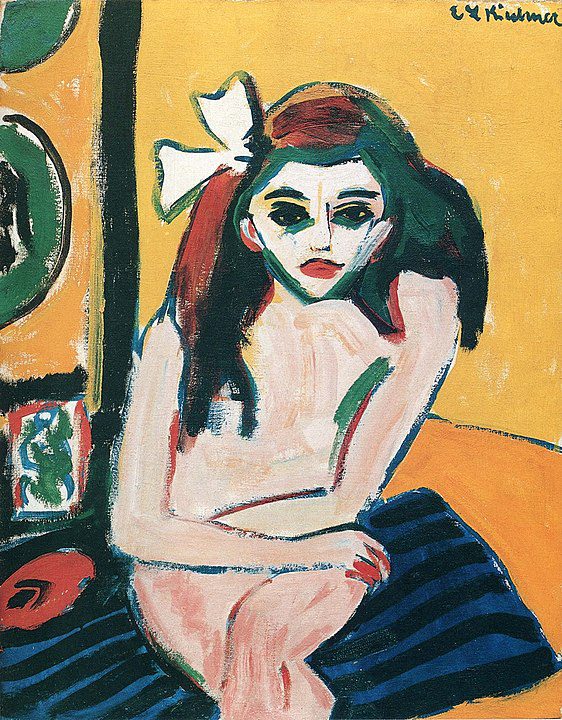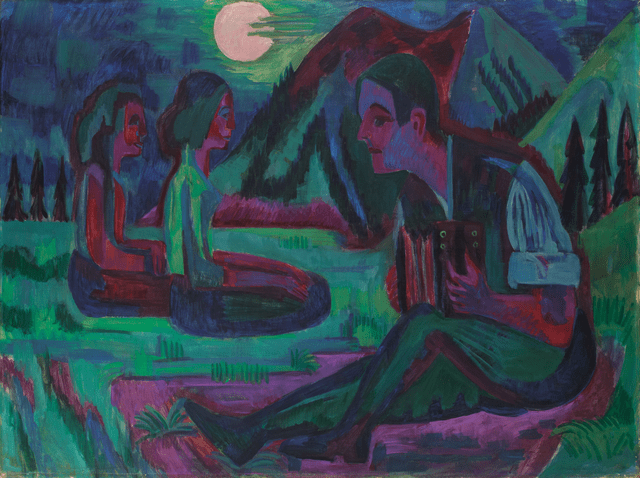
Ernst Ludwig Kirchner (1880-1938) was a German expressionist painter and printmaker, and one of the founding members of Die Brücke (The Bridge), a key group in the early 20th century that contributed significantly to the development of Expressionism in Germany. Born on May 6, 1880, in Aschaffenburg, Bavaria, Kirchner’s work is distinguished by its vivid emotionality and innovative use of color and form, reflecting the anxieties and upheavals of the modern world. His art spans a variety of mediums, including painting, printmaking, and sculpture, showcasing a bold, dynamic approach that sought to bridge the gap between traditional art forms and the burgeoning modernist movement. This biography delves into Kirchner’s life, his contributions to the Expressionist movement, and his enduring influence on modern art.

Kirchner’s early life was marked by a conventional education, but he soon pursued his passion for art, studying architecture at the Dresden Technical University before dedicating himself fully to painting. In 1905, together with Fritz Bleyl, Erich Heckel, and Karl Schmidt-Rottluff, Kirchner founded Die Brücke in Dresden. The group aimed to create a new form of art, one that rejected the academic standards of the time and was driven by a desire for emotional authenticity and expressive freedom. Die Brücke artists were deeply influenced by primitive art, the works of Edvard Munch, and the Fauves, drawing inspiration from their use of color and form to express inner feelings and experiences.
Bold & Aggressive
Kirchner’s style is characterized by the use of bold, dissonant colors and aggressive, distorted forms, a reflection of his interest in depicting the tension and alienation of urban life. His works often feature scenes of Berlin’s streets and nightlife, capturing the dynamism and decadence of the city. Kirchner’s figures are rendered with a raw, visceral energy, emblematic of the Expressionist movement’s fascination with the primal aspects of human existence.

The outbreak of World War I in 1914 had a profound impact on Kirchner, who served briefly in the German army before suffering a breakdown and being discharged. The trauma of the war and his subsequent nervous conditions deeply affected his work, leading to a more introspective and somber tone. His post-war art reflects his struggle with mental illness and his disillusionment with modern society, yet it retains the vibrant intensity and emotional depth that define his earlier works.
To The Alps
In the years following the war, Kirchner sought refuge in the Swiss Alps, where he continued to paint and work on prints. His later works are marked by a return to nature, with landscapes and alpine scenes that convey a sense of peace and recovery. However, Kirchner’s health continued to decline, and he struggled with addiction and depression.
Tragically, Kirchner’s life came to an early end when he took his own life on June 15, 1938, in Davos, Switzerland. His suicide was influenced by the rise of the National Socialist regime in Germany, which branded his art as “degenerate” and destroyed many of his works. Despite this, Kirchner’s legacy as a pioneering figure in Expressionism has only grown over time. His bold experimentation with color, form, and subject matter broke new ground in the exploration of psychological and emotional reality through art.

Kirchner’s influence extends beyond his contributions to Expressionism; he played a crucial role in shaping the modernist movement, inspiring generations of artists to explore new avenues of expression. His work continues to be celebrated for its intensity, innovation, and its profound insight into the human condition. Ernst Ludwig Kirchner remains a seminal figure in the history of 20th-century art, whose vision and creativity continue to resonate with audiences and artists alike.




